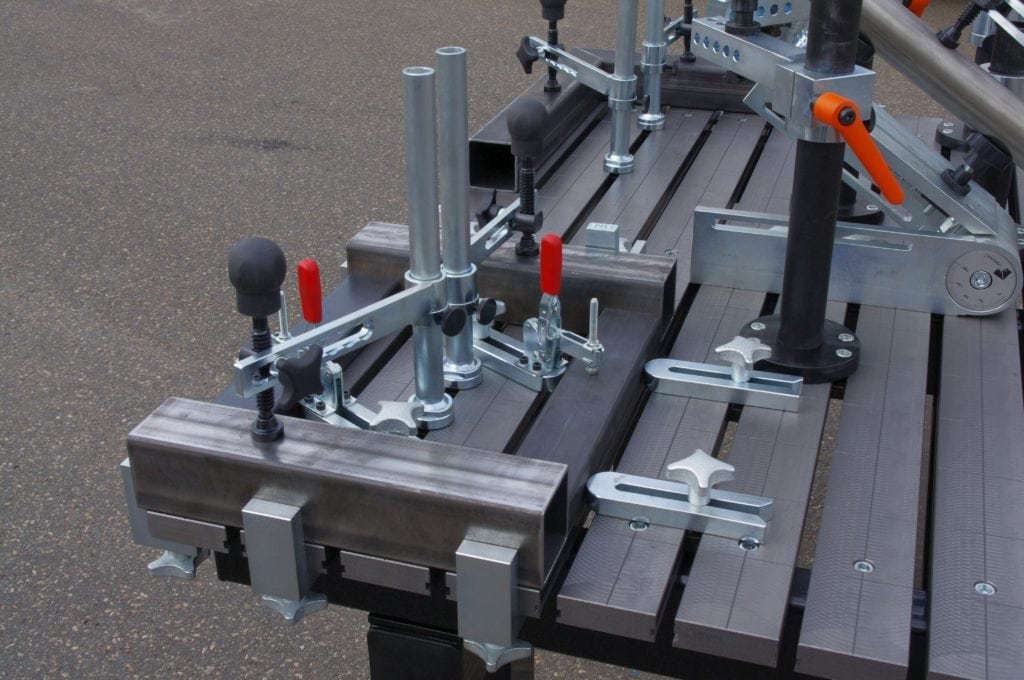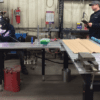In the days when welding was still a traditional craft, the welder’s most well-kept secret was his jigs. These were usually custom-made and then either welded to the worktable or attached using various welding fixtures, including regular clamps and vices of various types.
Jigs were (and still are) used to shape and bend metal, and for the assembly of specific designs. The primary purpose of a jig is to improve accuracy and enable the welder to replicate the manufacturing of a design repeatedly. But unlike a fixture that provides a secure mounting for the workpiece, and moves relative to it, a jig stays still and allows the workpiece to move.

Welding engineering demands quality that is consistently high coupled with maximum productivity and so the design of both jigs and high tech welding fixtures has improved dramatically over the past 25 years.
Traditionally jigs were used on a flat surface, so when complicated 3D designs were welded, there were additional challenges for the welder. Today, sophisticated modular welding tables, including those that lift and tilt, can be used with a range of innovative jigs and welding fixtures that ultimately improve quality and consistency of workmanship, and reduce production time, which in turn reduces costs.
Of course, the type of welding fixtures used will depend on what is being manufactured. So, for instance, if tanks are being constructed, the jigs and fixtures will need to have the ability to rotate components during the welding process. The equipment used should also be versatile so that it can be used to manufacture different sized tanks.
Workpiece positioners like turn-tilt modular welding tables are commonly used for both manual and robotic welding. There are many different designs that can accommodate different types of workpieces that might weigh anything from just a few pounds or kilos to several hundred tons. While the tilting axis of a turn-tilt table will also depend on its design, it could tilt about 135 degrees and turn by 365 degrees. Some can be adjusted hydraulically.
Forster America’s Ergonomic Welding Fixtures
Leaders in the manufacture of ergonomic welding fixtures, Forster’s specialist products include:
- Frame railing fixtures
- Railing welding fixtures
- A unique vacuum clamping system
Additionally, they offer a range of special welding jigs.
Frame railing fixtures
These welding fixtures enable welders to adjust workpieces on all four sides of the frame. The frame fixture can be swiveled to between 225 and 360 degrees, depending on the components being welded, so that the top and bottom of the workpiece are also accessible.
Suitable for both manual and robotic welding, most of Forster’s frame railing fixtures feature pneumatic load balancing and locking brakes, except for the largest 4500 model, which is motoric.
Railing welding fixtures
Intended for the production of railings, these railing welding fixtures accommodate workpieces ranging in height from 450 mm to 1200 mm that can rotate 360 degrees. They feature pneumatic load balancing and can reduce production time by as much as 50 percent.
Special welding jigs
Forster America’s special welding jigs are intended for frame constructions and large 3D assemblies. They are set at ergonomic working height and can be operated hydraulically or electrically.
All these welding fixtures and jigs have been designed for use with the company’s unique modular welding tables, to provide the best possible solutions for all welding jobs, big and small.


